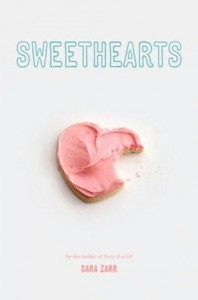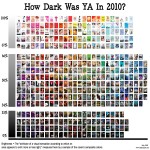 Welcome Back to YA Cafe, where book lovers can gather and chat about teen literature. I’m your barista, along with Ghenet from All About Them Words.
Welcome Back to YA Cafe, where book lovers can gather and chat about teen literature. I’m your barista, along with Ghenet from All About Them Words.
Each Friday we pick from a menu of topics and share our thoughts on our respective blogs. We’ve also got plans brewing for interviews, events and even some exciting giveaways, so stay tuned! Join the discussion by responding in the comments, on your own blogs or on twitter using the hash tag #yacafe.
Today we’re discussing Sara Zarr’s heart-breaking book: Sweethearts. This book, about two childhood best friends who are separated, then reunited, is fraught with emotion and at the end I definitely found myself in tears. (OK, so I admit I cry easily with books, but still. This one was a tear-jerker.) But today I’m not planning to gush about the book or blather on about how easily I cry (those ASPCA commercials on TV? Yep, I cry during those too). No, today I want to talk about flashbacks.
Perhaps one of the most central elements of Sweethearts is the series of flashbacks that reveals a traumatic memory tying the childhood best friends together. The book opens with a scene from this series and subsequent scenes are sprinkled throughout the first two-thirds of the novel. So, what makes these flashbacks work? What could be better? Here’s my analysis.
5 Tips for Using Flashbacks in Your Novel
1) Put the reader in the scene. In Sweethearts, all the back-story is revealed through actual flashbacks, not through exposition. In these snippets of scenes, we’re right there with the characters, experiencing the moment with them rather than being told about the moment from an after-the-fact point of view. By immersing the reader in the scene, the back-story feels more real and is much more effective at capturing the reader’s attention.
2) Consider verb tense and point of view. One of the elements that struck me about Sweethearts was that all the flashback moments are in present tense, while the rest of the book is written in past tense. What this does is that it adds immediacy to the flashback moments, as well as a sense of urgency. Also, by using different tenses in the flashbacks than the real-time text, Zarr makes it easier for the reader to identify when we’re in flashback mode and when we’re back in the present. This is a nifty technique that solves the problem of having to add headers to flashbacks with dates or what-have-you so that the reader knows where we are in the timeline. The present tense serves as enough of a cue.
3) Don’t forget to bring the reader back. The reason many writers are often encouraged to avoid flashbacks is because of a phenomenon dubbed “Disappearing Scene Syndrome” (I first heard this term at a lecture by author and teacher Peter Selgin). What this means is that sometimes writers will get so wrapped up in the flashback that they forget to bring the reader back to the present. Example: Your character is brushing her teeth and remembering a wild, crazy night she had partying with her girlfriends. The story continues following the women as they tour the party circuit and we never come back to the scene in the present where the main character is brushing her teeth. What Zarr does so beautifully in Sweethearts is that she always brings the reader back to the present after those intense flashback scenes.
4) Don’t make the flashback too long. A corollary to the previous tip, be careful about making flashbacks that are too long so that the reader doesn’t forget where we are in the actual timeline. The way Zarr resolves this problem is that she gives us a longer flashback right at the beginning (with a header and date so we know we’re in the past), but subsequent flashbacks are much shorter. She also does a great job of cutting off the flashback at a cliff-hanger so that we have to keep turning pages to find out what really happened. Again, a subtle technique, but very effective one.
5) Make sure there’s a pay-off. This is my one quibble with the flashbacks in Sweethearts. There is so much suspense and buildup to the grand finale that when we finally do discover what really happened, I’ll admit that I was slightly disappointed. I thought that the result would be much more terrifying. Don’t get me wrong, it was a painful scene (or series of scenes) to read, but I was expecting something much, much darker to be the end-result and when that didn’t happen, I felt like the author had led me to believe one thing and then given me another. Again, let me underscore that the actual series of flashbacks are very scary and dark. It’s just that with the rate of the build-up, I was expecting the climax of that sequence to be even darker than it ended up being. But this is all a minor quibble, considering how artfully Sara Zarr handles the flashbacks otherwise.
Take-home Message: In the end, it’s all about building trust with the reader and making sure that the reader understands where the story is in time and place. Flashbacks are tricky to handle well and the series in Sweethearts is artfully done. If you’re writing a book that involves a series of flashbacks, I definitely recommend reading Sweethearts by Sara Zarr as an example of how to do them. Actually, if you’re looking for a heartbreaking, heartfelt book, I would also recommend Sweethearts, because it’s just that: heartfelt and heartbreaking.
Want to read more about SWEETHEARTS: check out Ghenet’s response at All About Them Words. Then share your thoughts with us in the comments or on your own blog. (Don’t forget to leave a link in the comments so we can check it out!)







 Call me Gabi (pronounced gah-BEE). I'm a writer, freelance teacher, and a lover of books and words. I'm also the instigator of DIY MFA. iggi's my sidekick, but he thinks he's the brains behind this operation.
Call me Gabi (pronounced gah-BEE). I'm a writer, freelance teacher, and a lover of books and words. I'm also the instigator of DIY MFA. iggi's my sidekick, but he thinks he's the brains behind this operation.
 Goodbye is for Sissies
Goodbye is for Sissies YA Cafe: What YA Book are You Thankful For?
YA Cafe: What YA Book are You Thankful For? YA Cafe: Why I Love Dark YA
YA Cafe: Why I Love Dark YA YA Cafe: YA Appreciation Month
YA Cafe: YA Appreciation Month
Comments on this post
I agree that the flashbacks were handled very well. They were really suspenseful and I liked how we had to turn the page to find out what really happened.
These are great tips. I’m thinking of incorporating a flashback into my book so this was the perfect book for me to read to see how it’s done well. 🙂
26. August - 11:00 amI enjoyed the flashbacks in this book, but I totally agree, the flashbacks told in such small snippets built up so much suspense that the climax of the flashbacks was a little bit disappointing. And not just the flashbacks, but also discovering that Jenna hates her birthday because it’s the day the event happened makes you think something REALLY bad happened. But the story was so beautifully written with excellent character development, that I found myself forgiving Sara Zarr for my momentary disappointment. 🙂
26. August - 12:11 pmI agree that the flashback scenes themselves were very suspenseful (I kept thinking it was going to be one horrifying thing, then it grew into another and another) but then the final reveal was a letdown. It’s one of those times where letting the reader fill in the gaps was brilliant but then flopped because I imagined many worst case scenarious that were, y’know, worse. I think even letting the scene finish behind a closed door would have been darker than what happened– not knowing would have sucked, but again, filling in the gaps would have made each reader conjure up something suitably terrifying.
26. August - 1:16 pm@Sophia–I like your idea of letting the flashback thread end behind closed doors. In fact, a number of times–when the evil Dad closed the door, or when Jennifer locked him out of the room–I figured the sequence would end there and I’d be left to imagine the worst. Sort of sad that that’s not what happened.
@Jenn–I definitely agree that the rest of SWEETHEARTS is so well done, I didn’t mind the reveal in the flashbacks as much as I would have if the story been in the hands of a different author. Sara Zarr really worked magic at the end, especially with the role of the parents (loved your post @Ghenet!) and liked the way the ending was not your typical love story. Despite its flaws, a lovely book!
26. August - 1:44 pmThis is a great post and I’m encouraged to hear of a book successfully using flashbacks. I will definitely check it out. I’m frustrated with my WIP because I can’t yet tell how much of the backstory needs to be in it. For now I’m just writing forward and not worrying about that part.
27. August - 6:30 pm